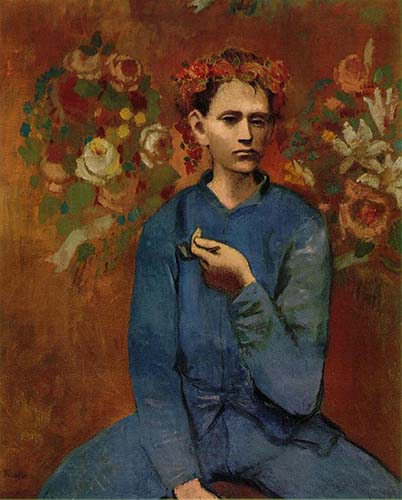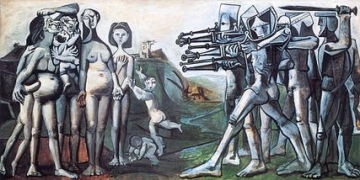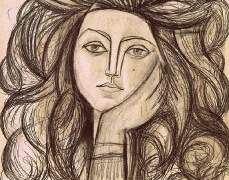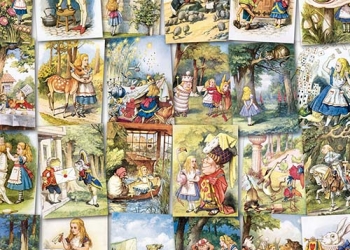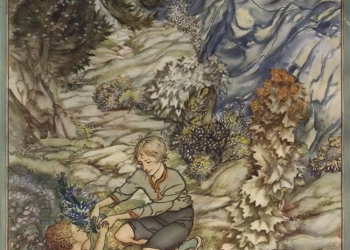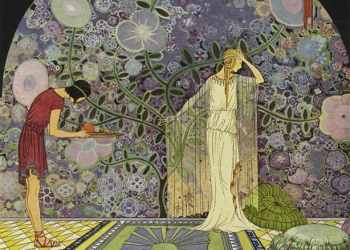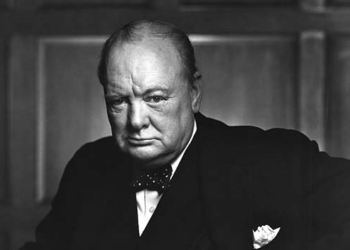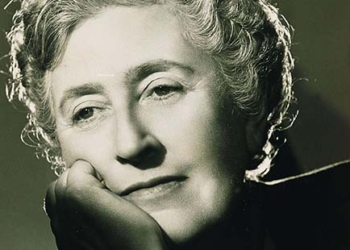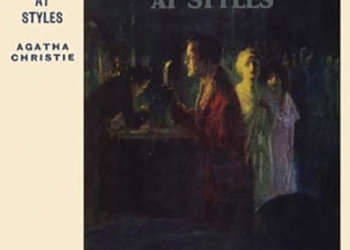Pablo Picasso [1905-06] Fernande con una mantiglia nera [art, paintings]
Pablo Picasso [1905-06] Portrait of Gertrude Stein [art, paintings]
Pablo Picasso [1905] - Acrobate et jeune arlequin2 [art, paintings]
Pablo Picasso [1905] - Acrobate et jeune arlequin3 [art, paintings]
Pablo Picasso [1905] - Acrobate et jeune arlequin4 [art, paintings]
Pablo Picasso [1905] - Arlequin a cheval [etude] [art, paintings]
Pablo Picasso [1905] - Arlequin a cheval [art, paintings]
Pablo Picasso [1905] - Arlequin avec enfant [art, paintings]
Pablo Picasso [1905] - Arlequin se grimant devant une femme assise [art, paintings]
Pablo Picasso [1905] - Arlequin sur un canape rouge [art, paintings]
Pablo Picasso [1905] - Arlequin [art, paintings]
Pablo Picasso [1905] - Artiste de cirque et enfant [art, paintings]
Pablo Picasso [1905] - Au Lapin Agile ou Arlequin avec un verre [art, paintings]
Pablo Picasso [1905] - Au bord du canal [art, paintings]
Pablo Picasso [1905] - Bouffon et jeune acrobate [art, paintings]
Pablo Picasso [1905] - Bouffon et jeune acrobate2 [art, paintings]
Pablo Picasso [1905] - Boy with a Pipe [art, paintings]
Pablo Picasso [1905] - Deux freres [art, paintings]
Pablo Picasso [1905] - Deux jeunes [art, paintings]
Pablo Picasso [1905] - Deux saltimbanques avec un chien [art, paintings]
Pablo Picasso [1905] - Equestrienne a cheval [art, paintings]
Pablo Picasso [1905] - Famille d'acrobates avec singe [art, paintings]
Pablo Picasso [1905] - Famille d'arlequin [art, paintings]
Pablo Picasso [1905] - Famille de bateleurs [art, paintings]
Pablo Picasso [1905] - Famille de bouffon [art, paintings]
Pablo Picasso [1905] - Famille de saltimbanques (Les bateleurs) [art, paintings]
Pablo Picasso [1905] - Famille de saltimbanques [etude] [art, paintings]
Pablo Picasso [1905] - Famille de saltimbanques2 [art, paintings]
Pablo Picasso [1905] - Family of Saltimbanques [art, paintings]
Pablo Picasso [1905] - Femme a l'eventail [art, paintings]
Pablo Picasso [1905] - Femme debout [art, paintings]
Pablo Picasso [1905] - Femme nue assise [art, paintings]
Pablo Picasso [1905] - Garcon a la pipe [art, paintings]
Pablo Picasso [1905] - Garcon au calecon noir [art, paintings]
Pablo Picasso [1905] - Garcon avec un bouquet de fleurs [art, paintings]
Pablo Picasso [1905] - Garcon avec un chien [art, paintings]
Pablo Picasso [1905] - Garcon bleu [art, paintings]
Pablo Picasso [1905] - Gros bouffon assis [art, paintings]
Pablo Picasso [1905] - Hollandaise au bord du canal [art, paintings]
Pablo Picasso [1905] - Jeune acrobat et enfant [art, paintings]
Pablo Picasso [1905] - Jeune fille nue avec panier de fleurs [art, paintings]
Pablo Picasso [1905] - Jeune fille [art, paintings]
Pablo Picasso [1905] - Jongleur et nature morte [art, paintings]
Pablo Picasso [1905] - Junon endormie [art, paintings]
Pablo Picasso [1905] - L'athlete [art, paintings]
Pablo Picasso [1905] - La belle Hollandaise [art, paintings]
Pablo Picasso [1905] - La coiffure [etude] [art, paintings]
Pablo Picasso [1905] - La famille d'arlequin [art, paintings]
Pablo Picasso [1905] - Le Bouffon [art, paintings]
Pablo Picasso [1905] - Le repas des acrobates [art, paintings]
Pablo Picasso [1905] - Le roi [art, paintings]
Pablo Picasso [1905] - Le roi2 [art, paintings]
Pablo Picasso [1905] - Le singe assis [art, paintings]
Pablo Picasso [1905] - Le violiniste (Famille avec singe) [art, paintings]
Pablo Picasso [1905] - Les trois hollandaises [art, paintings]
Pablo Picasso [1905] - Madeleine nue [art, paintings]
Pablo Picasso [1905] - Mallorquine [art, paintings]
Pablo Picasso [1905] - Mere et enfant (Baladins) [art, paintings]
Pablo Picasso [1905] - Mere et enfant1 [art, paintings]
Pablo Picasso [1905] - Mere et enfant2 [art, paintings]
Pablo Picasso [1905] - Mere et enfant3 [art, paintings]
Pablo Picasso [1905] - Nus entrelaces [art, paintings]
Pablo Picasso [1905] - Paysage dans les environs de Schoorl [art, paintings]
Pablo Picasso [1905] - Paysage dans les environs de Schoorl2 [art, paintings]
Pablo Picasso [1905] - Portrait de Madame Benedetta Canals [art, paintings]
Pablo Picasso [1905] - Profil droit de bouffon [art, paintings]
Pablo Picasso [1905] - Tete de bouffon [art, paintings]
Pablo Picasso [1905] - Tete de femme [art, paintings]
Pablo Picasso [1905] - Three Dutch Girls [art, paintings]
Pablo Picasso [1905] - Un bateau sur le canal [art, paintings]
Pablo Picasso [1905] - Woman in a Chemise [art, paintings]
Pablo Picasso [1906] - Autoportrait a la palette [art, paintings]
Pablo Picasso [1906] - Autoportrait1 [art, paintings]
Pablo Picasso [1906] - Autoportrait2 [art, paintings]
Pablo Picasso [1906] - Buste d'homme [art, paintings]
Pablo Picasso [1906] - Buste de femme [art, paintings]
Pablo Picasso [1906] - Cheval [art, paintings]
Pablo Picasso [1906] - Chevaux au bain [art, paintings]
Pablo Picasso [1906] - Coiffure [art, paintings]
Pablo Picasso [1906] - Couple [art, paintings]
Pablo Picasso [1906] - Deux femmes nues [art, paintings]
Pablo Picasso [1906] - Deux femmes nues1 [art, paintings]
Pablo Picasso [1906] - Deux femmes nues2 [art, paintings]
Pablo Picasso [1906] - Femme a la tete rouge [art, paintings]
Pablo Picasso [1906] - Femme assise2 [art, paintings]
Pablo Picasso [1906] - Femme debout [art, paintings]
Pablo Picasso [1906] - Femme nue debout [art, paintings]
Pablo Picasso [1906] - Femme nue sur pierre carree [art, paintings]
Pablo Picasso [1906] - Femme nue vue de dos avec enfant [art, paintings]
Pablo Picasso [1906] - Femme nue [art, paintings]
Pablo Picasso [1906] - Femme sur un ane [art, paintings]
Pablo Picasso [1906] - Fernande a la mantille [art, paintings]
Pablo Picasso [1906] - Fille a la chevre [art, paintings]
Pablo Picasso [1906] - Garcon au calecon2 [art, paintings]
Pablo Picasso [1906] - Garcon et fillette nus [art, paintings]
Pablo Picasso [1906] - Garcon nu [art, paintings]
Pablo Picasso [1906] - Gertrude Stein [art, paintings]
Pablo Picasso [1906] - Homme,femme, et enfant [art, paintings]
Pablo Picasso [1906] - Jeune espagnol [art, paintings]
Pablo Picasso [1906] - Jeune garcon nu [art, paintings]
Pablo Picasso [1906] - Jeune homme et cheval [art, paintings]
Pablo Picasso [1906] - Jeune homme et cheval2 [art, paintings]
Pablo Picasso [1906] - La coiffure [art, paintings]
Pablo Picasso [1906] - La coiffure2 [art, paintings]
Pablo Picasso [1906] - La coiffure3 [art, paintings]
Pablo Picasso [1906] - La mort d'arlequin [art, paintings]
Pablo Picasso [1906] - La porteuse de pains [art, paintings]
Pablo Picasso [1906] - La toilette [etude] [art, paintings]
Pablo Picasso [1906] - La toilette1 [art, paintings]
Pablo Picasso [1906] - La toilette2 [art, paintings]
Pablo Picasso [1906] - La toilette3 [art, paintings]
Pablo Picasso [1906] - La toilette4 [art, paintings]
Pablo Picasso [1906] - La toilette5 [art, paintings]
Pablo Picasso [1906] - Le Harem [art, paintings]
Pablo Picasso [1906] - Les adolescents [art, paintings]
Pablo Picasso [1906] - Les adolescents2 [art, paintings]
Pablo Picasso [1906] - Les deux freres2 [art, paintings]
Pablo Picasso [1906] - Les deux freres3 [art, paintings]
Pablo Picasso [1906] - Les paysans2 [art, paintings]
Pablo Picasso [1906] - Marins en bordee [art, paintings]
Pablo Picasso [1906] - Meneur de cheval nu1 [art, paintings]
Pablo Picasso [1906] - Meneur de cheval nu2 [art, paintings]
Pablo Picasso [1906] - Meneur de cheval nu3 [art, paintings]
Pablo Picasso [1906] - Nature morte au tableau [art, paintings]
Pablo Picasso [1906] - Nature morte aux vases1 [art, paintings]
Pablo Picasso [1906] - Nu aux mains jointes [art, paintings]
Pablo Picasso [1906] - Nu couche (Fernande) [art, paintings]
Pablo Picasso [1906] - Nu sur fond rouge [art, paintings]
Pablo Picasso [1906] - Nu, etude pour le harem [art, paintings]
Pablo Picasso [1906] - Paysage de Gosol [art, paintings]
Pablo Picasso [1906] - Portrait d'Allan Stein [art, paintings]
Pablo Picasso [1906] - Portrait de Fernande Olivier au foulard [art, paintings]
Pablo Picasso [1906] - Portrait de Fernande [art, paintings]
Pablo Picasso [1906] - Portrait de Gertrude Stein [art, paintings]
Pablo Picasso [1906] - Portrait de femme [art, paintings]
Pablo Picasso [1906] - Satyre et jeune fille [art, paintings]
Pablo Picasso [1906] - Taureau [art, paintings]
Pablo Picasso [1906] - Tete de Josep Fondevila [art, paintings]
Pablo Picasso [1906] - Tete de Josep Fondevila2 [art, paintings]
Pablo Picasso [1906] - Tete de femme au chignon - Profil [art, paintings]
Pablo Picasso [1906] - Tete de femme, de face [art, paintings]
Pablo Picasso [1906] - Tete de femme [art, paintings]
Pablo Picasso [1906] - Tete de jeune homme [art, paintings]
Pablo Picasso [1906] - Tete de jeune homme2 [art, paintings]
Pablo Picasso [1906] - Tete [art, paintings]
Pablo Picasso [1906] - Trois nus [art, paintings]
